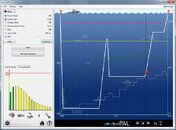SWAMPY459
Contributor
Hi,
I have a question about dives that have more than one level, where one of the levels is very shallow. I think I have this correct, but want some input to make sure I'm right.
Let's use Troy Springs as an example dive...
There is a spring that has a 75 ft "chimney".... let's say I go down to that 75 ft depth for about 15 minutes...
Then I come up out of the chimney into the flat part of the springs and dive around in shallow water between 10 and 20 feet deep for 20 minutes.
Then I wait 30 minutes before my next dive....
When I'm calculating this I count...
15 minutes @ 75 ft
don't count any minutes at 10-20 ft (call this an extended safety stop) but don't count it as surface interval either
and 30 minutes as surface interval ...
right?
basically, I'm asking... "The time I spend diving at less than 8 meters, I don't count as bottom time or surface interval... it's sort of a blacked out time" right?
now, carrying that further,
if on a dive I go to 75 feet come up to 20 feet for a little while... then back down to say 50 feet... then up for a proper safety stop at the end of the dive.. I don't count the 20 feet portion at all...
example...
75 feet for 10 minutes... 20 feet for [-]12 minutes[/-]... 50 feet for 10 minutes... safety stop at 15 feet [-]3 minutes[/-]...
I could use my table to figure this as a 75 foot dive for 20 minutes...
right?
I have a question about dives that have more than one level, where one of the levels is very shallow. I think I have this correct, but want some input to make sure I'm right.
Let's use Troy Springs as an example dive...
There is a spring that has a 75 ft "chimney".... let's say I go down to that 75 ft depth for about 15 minutes...
Then I come up out of the chimney into the flat part of the springs and dive around in shallow water between 10 and 20 feet deep for 20 minutes.
Then I wait 30 minutes before my next dive....
When I'm calculating this I count...
15 minutes @ 75 ft
don't count any minutes at 10-20 ft (call this an extended safety stop) but don't count it as surface interval either
and 30 minutes as surface interval ...
right?
basically, I'm asking... "The time I spend diving at less than 8 meters, I don't count as bottom time or surface interval... it's sort of a blacked out time" right?
now, carrying that further,
if on a dive I go to 75 feet come up to 20 feet for a little while... then back down to say 50 feet... then up for a proper safety stop at the end of the dive.. I don't count the 20 feet portion at all...
example...
75 feet for 10 minutes... 20 feet for [-]12 minutes[/-]... 50 feet for 10 minutes... safety stop at 15 feet [-]3 minutes[/-]...
I could use my table to figure this as a 75 foot dive for 20 minutes...
right?




